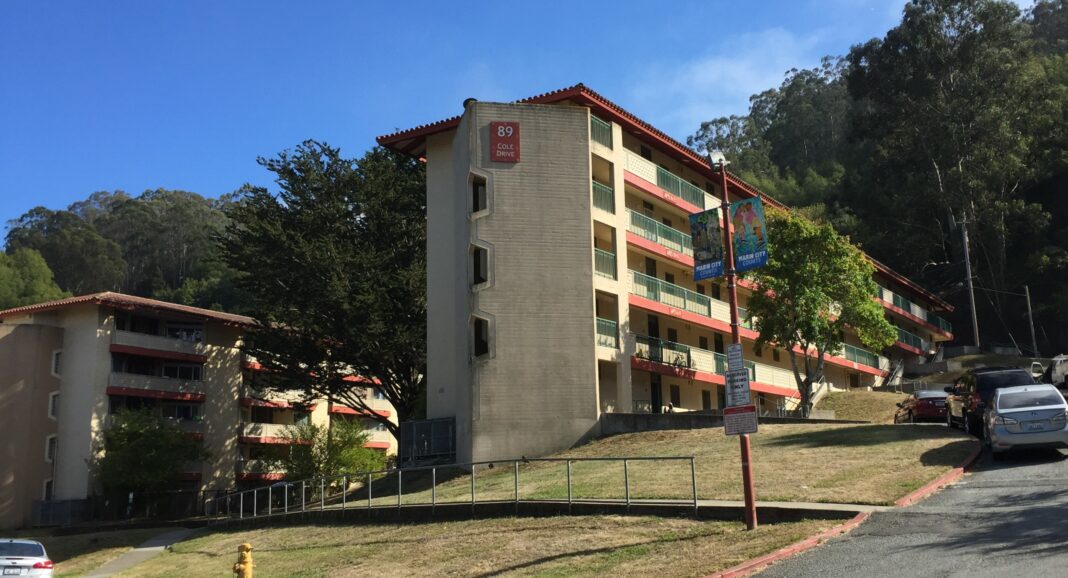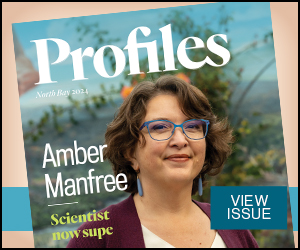Royce McLemore, president of the Golden Gate Village Resident Council, is within a few steps of achieving the goal she has been working toward for almost a decade. It has been McLemore’s dream to restore the neglected and decaying public housing complex in Marin City.
Golden Gate Village has been home to McLemore, 79, for most of her life. She has battled for years with the Marin Housing Authority over their failure to provide safe and sanitary living conditions. The apartments are rife with mold, rodents, plumbing leaks, broken heating, faulty wiring and fire hazards, according to residents.
The significance of Golden Gate Village often goes unrecognized. Completed in 1961, Aaron Green, a protégé of Frank Lloyd Wright, designed the 32-acre public housing development for Black people who had built Liberty ships in nearby Sausalito during World War II. Almost 6,000 shipyard workers lived in temporary housing in Marin City; however, white people left after the war, with money in their pockets from their well-paying jobs. Black people also had money but stayed in Marin City because of redlining, the discriminatory practice of preventing them from buying homes in other areas of the county.
Today, Golden Gate Village is listed on the National Register of Historic Places. The 296 units house about 700 predominantly Black residents, many of whom are descendants of the shipbuilders. Notably, Golden Gate Village is the only public housing in Marin that accepts children.
In an effort to preserve the historic property, McLemore and the resident council recruited a volunteer strategy team several years ago. The diverse team includes a real estate developer, an attorney, a certified public accountant and other professionals who assisted the resident council in putting together a viable plan to rehabilitate Golden Gate Village.
The Marin Housing Authority’s seven-member board, composed of the Marin County Board of Supervisors and two community members, voted in March to recommend the resident council’s revitalization plan to the U.S. Department of Housing and Urban Development (HUD), which is overseeing the process.
In fact, HUD is scrutinizing the Marin Housing Authority, after threatening to take over the agency in May 2021, due to repeated “failing or near failing physical scores” at Golden Gate Village. The housing authority is under a corrective action plan, which includes deadlines.
To stay on track for HUD and flesh out the details of the resident plan, the housing authority board voted in March 2022 to form a “working group.” A facilitator was hired, costing the county $110,000. Marin County Supervisor Stephanie Moulton-Peters and an equal number of representatives from the housing authority and Golden Gate Village were appointed to the working group.
The members participated in about 20 Zoom meetings, from May 27-Oct. 28, and agreed on many aspects of the resident council plan. Both the Marin Housing Authority and the resident council concur on using green and sustainable building practices for the property’s revitalization, while also preserving its historic qualities. Ditto for keeping Golden Gate Village affordable for low-income residents.
Unfortunately, two major sticking points, homeownership and project financing, have caused a stalemate between the two factions of the working group. The housing authority decided to present the board with an alternate financing plan, one which effectively blocks residents from a pathway to homeownership in Golden Gate Village.
Two plans now compete for the board’s approval. Both were revealed at a Marin Housing Authority board meeting on Oct. 18, and a final vote will take place at the Nov. 15 board meeting.
The Golden Gate Village Resident Council proposes financing the project with a mortgage, an approach they admit would leave a gap of $26 million. However, a financing consultant working with the group helped them identify reputable funding sources, mostly grants, to bridge the gap.
This financing conforms with a Limited Equity Housing Cooperative (LEHC), a homeownership model designed for affordable housing communities, which is a key component of the resident council’s plan. Under the LEHC, Golden Gate Village residents would establish a nonprofit corporation that owns the buildings and each resident would have the option of buying a share in the corporation, initially at a subsidized price. As shareholders, residents become homeowners, allowing them to build limited equity and pass on the property to their heirs.
Section 8 project-based vouchers held by the residents would help pay for the monthly expenses. The LEHC may also apply for grants for capital improvements and other community needs.
Most importantly, co-op residents would elect their own board of directors and hire a management company to take care of day-to-day operations. No longer beholden to the housing authority, the residents would self-govern for the first time in Golden Gate Village’s 61-year history.
Conversely, the Marin Housing Authority prefers to keep control of Golden Gate Village, which contains more than half of Marin County’s public housing stock. The housing authority plans to finance the renovations through Low-Income Housing Tax Credits, ruling out homeownership for residents. In addition, the housing authority contends the LEHC model presents regulatory problems.
“The resident council’s goals and the approach for a LEHC are at odds with Section 8 Project Based Vouchers requirements in HUD’s regulations,” Kimberly Carroll, executive director of the Marin Housing Authority, said in an email.
Not so, according to Barbara Bogard, who is a member of the working group and the strategy team assisting the resident council. Other public housing developments that have converted to the LEHC model still meet Section 8 requirements, Bogard said.
Golden Gate Village residents don’t trust the housing authority to perform ongoing maintenance of the property after the rehabilitation is complete. The current degraded condition was caused by the housing authority’s neglect, although it has consistently blamed underfunding for the maintenance backlog and inability to make capital improvements.
“For many years, Congress has failed to fully fund federal housing programs, including the Public Housing Capital Fund and Public Housing Operating Fund,” Carroll said. “…The MHA is dealing with the same challenges that public housing authorities throughout the country are facing.”
While Carroll’s statement is accurate, underfunding is not an excuse for failing to maintain Golden Gate Village. In 2018, Jane Winter, then-executive director of the financially healthy YWCA Apartments in San Francisco, also funded by HUD, brought this to the attention of the Marin Housing Authority in a letter.
“High quality professional affordable housing operators all know HUD funding is not available for major capital projects, and they plan well in advance to secure non-HUD funding for items that go beyond annual maintenance and repair,” Winter wrote.
Examples of such funding were included in the letter, yet the Marin Housing Authority never acted on any of Winter’s suggestions until now. Their proposal presented to the board on Oct. 18 includes one of the recommended financing options.
Both the housing authority and the resident council seem entrenched in their positions, despite months of working group meetings. The Golden Gate Village contingent believes the playing field wasn’t level.
For instance, the working group facilitator silenced McLemore, the resident council president, by turning off her microphone several times during meetings, said Lisa Bennett, a strategy team member who also serves in the working group.
The resident council contends racism has been a component of the meetings as well. Marin County Supervisor Moulton-Peters, a member of the working group, made a racist remark, according to Bogard.
The Pacific Sun verified that Moulton-Peters made the following comment by watching the video from the Sept. 23 working group meeting:
“Running a co-op requires financial, legal and operational expertise,” Moulton-Peters said. “I would want to understand where that expertise lies in the resident population. My sense is if it were in the resident population, then the strategy team would not have been needed. So that’s just a working theory I have. But this is a serious endeavor. I think it’s fair to ask that question, too. Where is the expertise that would run the co-op within the resident population?”
Moulton-Peters told the Pacific Sun in an interview that she did use these words during the meeting and clarified what she meant by the statement.
“I didn’t intend it to be that way,” Moulton-Peters said. “I believe the Golden Gate Village residents can manage the property with the management company.”
If the other housing authority board members agree with Moulton-Peters, then why not let the residents have a housing co-op at Golden Gate Village?
Marin County is proficient at performative measures rather than making meaningful changes for underserved communities. Last week, the county announced it is “taking black Sharpies to racist language” in real estate deeds, literally crossing out the words that prohibited Black people from purchasing property. While it sounds nice in the press release, it doesn’t provide redress to those impacted by redlining.
Marin County stole homeownership opportunities from Marin City’s Black residents after WWII. Giving the residents of Golden Gate Village a chance to own property would be a small step towards righting a huge wrong.
__________________________________
Tell the Marin Housing Authority Board of Commissioners which plan you support before they vote on Nov. 15:
Katie Rice [email protected]
Stephanie Moulton-Peters [email protected]
Damon Connolly [email protected]
Dennis Rodoni [email protected]
Judy Arnold [email protected]
Homer Hall [email protected]
Sarah Canson [email protected]













Hello Nikki,
An excellent article! The Mill Valley Seniors for Peace have been supporting the GGV Residents Council for over 3 years. We regularly speak at BOC meetings and are actively involved in the leadership team of Friends of Golden Gate Village. As part of the FoGGV’s current work in preparing for the Nov. 15th BOC meeting, we are sponsoring a Rally demonstrating community support for the Residents Plan tomorrow afternoon at our well-used corner, Camino Alto & Miller. We anticipate a good sized crowd, including students from nearby Tam Hi and Mt. Tam School’s 7th and 8th graders
Would you be able to join us?
In a separate email I will send a copy of the flyer promoting our even and a copy of information we have been sending to community members that we think might share our interest in seeing social justice realized at GGV.
Warmly,
Nancy Miller, Co-Chair, MVSFP
Thank you, Nancy. I look forward to receiving your flyer about the event tomorrow. [email protected]
Hi Nikki,
Thank you for the coverage and important information. Unfortunately, unbeknownst to you, Ms. Carroll made a blatantly false statement regarding the conflict of LEHCs with HUD’s regulations. The 2 have been used together in multiple projects in California alone. I wish they would stop trying to justify the past and find their way to supporting the plan of the Residents which would finally change the trajectory of their lives for the better. Sadly the “new page” narrative is just that…a narrative to spin for the same old result.
Hi Rebekah,
Barbara Bogard disputed Kimberly Carroll’s statement in the next paragraph.
Best,
Nikki
I can’t get help on a serious issues ms Royce Mclamore, started around election time her conduct is not right because she is p